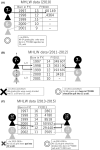Corrected human papillomavirus vaccination rates for each birth fiscal year in Japan
- PMID: 32248632
- PMCID: PMC7293087
- DOI: 10.1111/cas.14406
Corrected human papillomavirus vaccination rates for each birth fiscal year in Japan
Abstract
In Japan, the serious adverse events after human papillomavirus (HPV) vaccination were widely reported in the media. The Ministry of Health, Labour and Welfare of Japan (MHLW) announced the suspension of the governmental recommendation of HPV vaccine in 2013, and the inoculation rate has since sharply declined. The estimated inoculation rate for each birth fiscal year (FY) announced by the MHLW and the actual numbers for each birth FY surveyed by local governments were very different. In particular, the cumulative vaccination rate of girls born in FY2000 was regarded to be as high as 42.9% by the Council of the MHLW. However, this estimation included a confusion. When the suspension of the governmental recommendation was announced in FY2013, the girls born in FY2000 turned 13 years old, the targeted starting age of the HPV vaccination. The vaccination rate of this generation is considered to be quite low. The numbers were recalculated in this study. This study revealed that the real vaccination rate is only 14.3%. Female individuals born in or after FY2000 have been confirmed to be exposed to the same cervical cancer risk as before the HPV vaccine was introduced in Japan.
Keywords: Japan; fiscal year; governmental suspension of recommendation; vaccination rate; vaccine.
© 2020 The Authors. Cancer Science published by John Wiley & Sons Australia, Ltd on behalf of Japanese Cancer Association.
Conflict of interest statement
AY received a lecture fee from Merck Sharp & Dohme. YU received lecture fees, a research fund (grant number J550703673), and a consultation fee from Merck Sharp & Dohme. TK received a research fund (VT#55166) from Merck Sharp & Dohme. This study was partially funded by the Japan Agency for Medical Research and Development (grant number 15ck0106103h0102).
Figures



References
-
- Yagi A, Ueda Y, Kakuda M, et al. Epidemiologic and clinical analysis of cervical cancer using data from the population‐based osaka cancer registry. Cancer Res. 2019;79(6):1252‐1259. - PubMed
-
- Bruni L, Diaz M, Barrionuevo‐Rosas L, et al. Global estimates of human papillomavirus vaccination coverage by region and income level: a pooled analysis. Lancet Global Health. 2016;4(7):e453‐e463. - PubMed
-
- Ueda Y, Enomoto T, Sekine M, Egawa‐Takata T, Morimoto A, Kimura T. Japan’s failure to vaccinate girls against human papillomavirus. Am J Obstet Gynecol. 2015;212(3):405‐406. - PubMed
-
- Hanley SJ, Yoshioka E, Ito Y, Kishi R. HPV vaccination crisis in Japan. Lancet. 2015;385(9987):2571. - PubMed
-
- Sekine M, Kudo R, Adachi S, et al. Japanese crisis of HPV vaccination. Int Pathol Clin Res. 2016;2:039.

